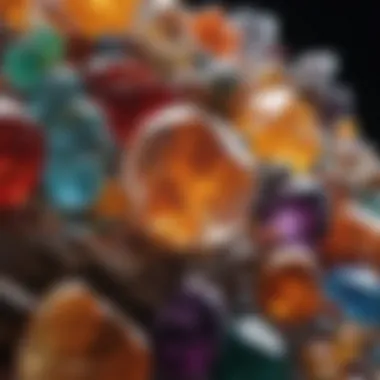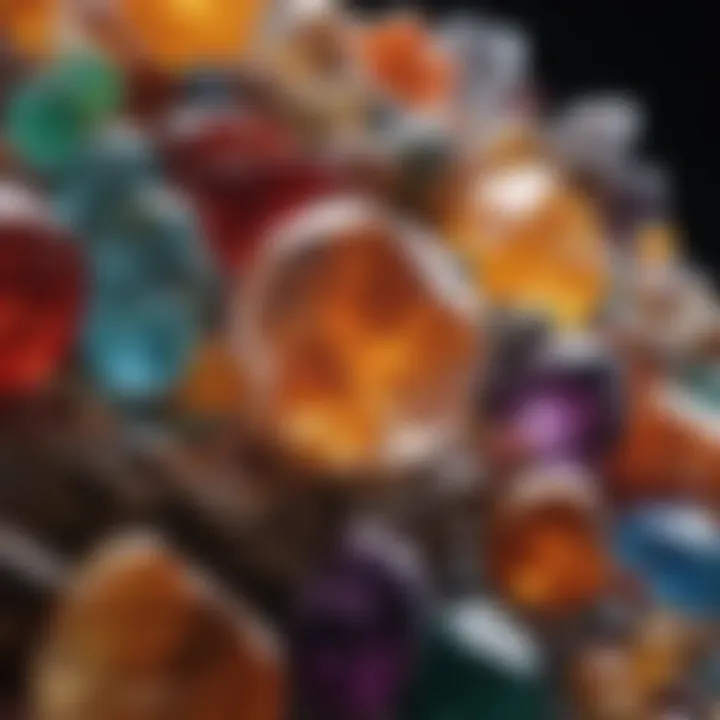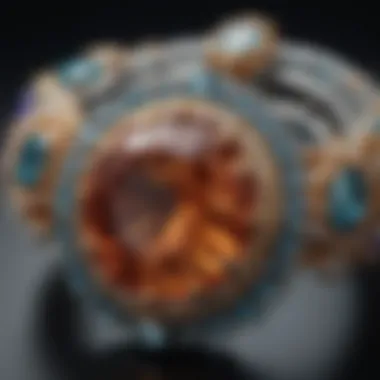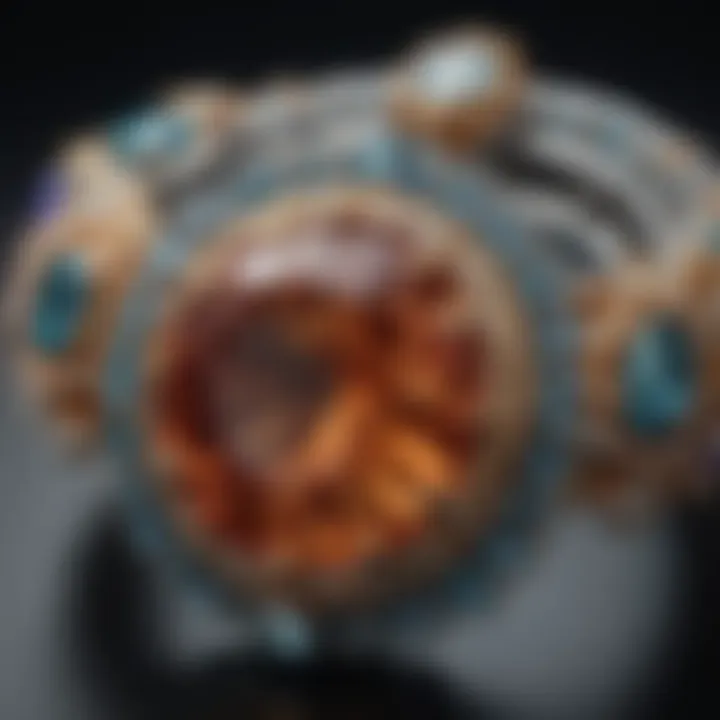Exploring Semi-Precious Cut Stones: A Comprehensive Guide


Intro
The world of semi-precious stones is as varied and rich as the hues that color them. Unlike their more famous counterparts, the precious gemstones like diamonds or sapphires, semi-precious stones bring a unique character and diversity to the realm of jewelry and ornamentation. They are far from being mere knock-offs; each stone tells a story rooted in geology, culture, and personal significance.
For anyone delving into the beauty of these gems, understanding what sets them apart is vital. From lush verdant emeralds to the serene blues of lapis lazuli, these gems captivate with their elegance and history. In this guide, we will traverse the landscape of semi-precious stones, exploring their geological origins, properties, and how they find their spaces in modern design and culture.
Gemstone Overview
Definition and Origins
Semi-precious stones are defined not by their lack of beauty or rarity, but by their classification in the broader gemological landscape. Generally, these gems are characterized as any stone that doesn’t hold the same status as precious stones like diamonds, rubies, sapphires, and emeralds. The origins of these stones vary widely, with many formed from metamorphic processes, volcanic activity, or sedimentation.
Some well-known examples include:
- Amethyst – Formed from volcanic eruptions, known for its violet hue.
- Turquoise – Created from the weathering of copper minerals, it boasts a stunning blue tint.
- Carnelian – An agate that finds its roots in layers of chalcedony, revered for its rich orange tones.
Historical Significance
Throughout history, semi-precious stones have held significant roles across cultures. In ancient Egypt, turquoise and lapis lazuli adorned the pharaohs, symbolizing power and divinity. Meanwhile, civilizations like the Aztecs revered jade not only for its beauty but also for its believed protective properties. The significance extends into modern times, as these stones are used in talismans, jewelry, and amulets, often believed to carry metaphysical properties.
"Each stone is not just a piece of nature; it's a manifestation of ancient cultures and beliefs, holding stories untold."
Gemstone Properties
Hardness and Durability
When considering semi-precious stones, the hardness and durability are vital aspects. The Mohs scale of mineral hardness measures these properties and helps to determine how well a gemstone can withstand wear and tear.
For example:
- Quartz ranks at 7, making it suitable for everyday wear.
- Turquoise, on the other hand, ranks lower at around 5 to 6, which means extra care should be taken.
Color and Clarity
Color is often the first thing that catches one’s eye with semi-precious stones. Different stones display a vast array of colors influenced by their chemical composition. Clarity, too, plays a pivotal role; this refers to the transparency and the presence of inclusions within the stone. The clarity can affect not only the visual appeal but also the overall value of the stone.
Choosing semi-precious stones requires an eye for these characteristics. A vibrant green peridot can stand out in a collection, while a clear, high-quality amethyst sparkles with elegance under light. Keeping this in mind enhances not only the appreciation of these stones but also assists in selecting pieces that resonate personally.
Prelude to Semi-Precious Cut Stones
The world of gemstones, particularly semi-precious cut stones, is a vibrant tapestry woven with both natural beauty and rich history. Understanding these stones offers a glimpse not only into their aesthetic value but also into the myriad of stories they carry — from their formation beneath the Earth's crust to their place in human culture.
Definition and Classification
Semi-precious stones account for a significant portion of the gem market. Unlike their more prized counterparts, such as diamonds and rubies, these stones often offer unique colors and patterns that can be simply stunning. But what exactly defines a semi-precious stone?
Generally, the term 'semi-precious' refers to any gemstone that isn't classified as precious. This classification can be influenced by factors including rarity, hardness, and overall quality. Examples of semi-precious stones encompass a vast array: amethyst, topaz, citrine, with each boasting unique properties. The Mohs scale, a widely accepted measure of hardness, often serves as a guide when classifying these stones. For instance, amethyst sits at a solid seven, making it a durable choice for jewelry, while softer stones like malachite rank lower on the scale, indicating a more careful approach to their use in daily wear.
Furthermore, within this classification, there exist distinctions based on hue, clarity, and geographical origin. The same stone can vary vastly based on where it’s found, and that adds to its allure. Collectors and enthusiasts often find joy in studying these variations, cultivating an appreciation that goes beyond just aesthetics.
Historical Significance
The significance of semi-precious stones isn’t merely confined to their beauty. Throughout history, cultures across the globe have cherished these stones, assigning them meanings that intertwine with human experience. For instance, in ancient Egypt, turquoise was adored for its soothing blue and believed to bring protection in the afterlife. The Aztecs and Incans valued lapis lazuli, not just for its color, but also for its association with the divine.
Moreover, as civilizations advanced, so did the utilization of these stones. During the Renaissance, affluent artisans cherished semi-precious stones for their decorative qualities, incorporating them boldly into various forms of art, from illuminated manuscripts to royal regalia. The techniques of cutting and polishing were refined over centuries, evolving into the precision we see today.
"The stones we wear today tell tales of centuries gone by, echoing with the dreams and aspirations of those who valued them before us."
As collectors or jewelry design enthusiasts, knowing this history not only enriches our appreciation but also helps contextualize our specimens. Each piece, be it an elegant pendant or an intricate ring, carries with it remnants of the past, waiting for the right moment to be cherished again. The excitement lies not just in owning these stones, but in connecting with their rich narratives, bridging the gap between history and modernity in every glimmering facet.
The Geology Behind Semi-Precious Stones
Understanding the geology behind semi-precious stones is crucial for anyone interested in these natural wonders. It sets the stage for appreciating their beauty and rarity. Every gem carries a story, a narrative written in the language of Earth’s processes. This section will explore two key aspects: how these stones form and where they can be found on our planet.
Formation Processes
The formation of semi-precious stones is a testament to nature’s incredible artistry. These stones are the result of various geological processes that take place over millions, if not billions, of years.
- Igneous Processes: Many semi-precious stones, such as amethyst and topaz, form from molten rock. When magma cools, it crystallizes into minerals. The timing and cooling conditions shape their qualities. A slow cooling process allows larger crystals to develop, while rapid cooling leads to smaller ones.
- Metamorphic Processes: Other stones undergo transformation under pressure and heat. For instance, malachite is formed from the alteration of copper ore, creating its distinctive green patterns. The pressure and temperature cause changes at an atomic level, resulting in new crystal structures.
- Sedimentary Processes: Some semi-precious stones develop in sedimentary environments. Citrine, for example, can originate from the sedimentation of quartz crystals in riverbeds, gradually accumulating in layers over time.
- Organic Processes: A rare group forms through biological activities. Jet, a precursor to coal, forms from decomposed wood under heat and pressure.
These processes result in each stone possessing unique characteristics, from color to clarity, influencing their desirability in jewelry and ornamentation. Understanding these processes not only deepens appreciation but also assists gem enthusiasts in making informed purchasing decisions.
Geographical Distribution


The geographical distribution of semi-precious stones is as diverse as the stones themselves. Different stones are found in various parts of the world, influenced by factors like geology, climate, and human activity.
- Amethyst: Commonly found in Brazil and Uruguay, but also in places like South Korea and Russia.
- Citrine: Mostly harvested from Brazil and the U.S., with distinct types available from Spain and Madagascar.
- Topaz: Brazil and China are major suppliers, with other notable sources in Russia and Nigeria.
- Malachite: Predominantly found in the Democratic Republic of the Congo and Russia.
The location impacts the quality and price of the stones. For example, market value might differ between Brazilian and Russian amethyst, depending on clarity, saturation, and size. Knowledge about geographical origins can also reveal the stone's environmental and ethical implications.
"When you know where a stone comes from, you appreciate not just its beauty but the history and heritage tied to that location."
In summary, the geology of semi-precious stones encompasses a fascinating interplay of formation processes and geographical factors. This relationship adds depth to their allure, allowing enthusiasts to understand and value these gemstones beyond their visual appeal.
Types of Semi-Precious Cut Stones
Understanding the diverse types of semi-precious cut stones is an essential thread in the fabric of this guide. These stones range from the widely adored to the rare and less common, each offering its own unique aesthetic and significance. Knowing about these varieties allows collectors, enthusiasts, and artists to make informed decisions whether they’re looking to invest, create, or simply appreciate the art of gemology. Distinguishing between popular and less known types can greatly enhance the richness of one’s collection or selection.
Popular Varieties
Amethyst
Amethyst stands out prominently among semi-precious stones, recognized for its striking purple hue, which can range from pale lavender to deep violet. It is typically thought to evoke a sense of calm, often associated with tranquility and clarity of mind. A notable point about Amethyst is its historical importance; in ancient times, it was valued as a protective stone, believed to ward off drunkenness. This lends it an aesthetic appeal that resonates with many, making it a popular choice for jewelry.
One unique feature of Amethyst is its ability to exhibit different shades based on factors like light exposure and surroundings. However, while its beauty is unquestionable, Amethyst does have a vulnerability to heat, which can alter its coloring. Thus, careful handling is advised when considering Amethyst for high-end pieces or everyday wear.
Citrine
Citrine, often called the "merchant’s stone," is celebrated for its warm yellow to golden brown hues. This stone is said to carry the energy of the sun, embodying brightness and positivity. Its vibrant color makes it a highly sought-after option for both casual jewelry and more refined designs. Citrine is also regarded for its durability, as it ranks a solid seven on the Mohs scale, providing it a robust advantage in daily wear.
What sets Citrine apart is its rarity in nature; most stones on the market are heat-treated Amethyst. It’s essential to recognize this when considering purchase options. Although Citrine is stunning, if it is not sourced properly, buyers risk receiving heat-treated stones that may not retain the intended value. This crucial factor highlights the need for acquiring Citrine through reputable dealers.
Topaz
Topaz showcases a fascinating palette—ranging from colorless to shades of blue, green, and even pink. It's a versatile gemstone that appeals broadly due to this diverse color range. Often associated with love and affection, Topaz is seen as a beneficial stone for connecting with deep emotional energies. Its brilliance rivals that of many precious stones, making it a popular choice for stunning engagement rings and other glamorous pieces.
One of the unique features of Topaz is its high clarity, which allows for beautiful, striking designs. Nonetheless, it is important to exercise caution when working with Topaz, for its hardness can lead to chipping if struck at certain angles. Proper care and design consideration play pivotal roles when utilizing Topaz in intricate jewelry.
Less Common Types
Tourmaline
Tourmaline is a fascinating gemstone known for its wide array of colors, sometimes even within a single crystal. It is often associated with grounding and emotional balance, making it a valuable stone for personal wellness. This wide color spectrum allows for considerable versatility in jewelry design, appealing to those who appreciate individuality in their accessories.
A remarkable aspect of Tourmaline is its capacity to become electrically charged when heated or placed under pressure. This characteristic has made it a subject of intrigue in both scientific and artistic worlds. However, some varieties of Tourmaline can also be quite pricey, particularly those that showcase vivid colors. Therefore, potential buyers should assess their choices with a keen eye on authenticity and quality.
Moonstone
Moonstone, renowned for its ethereal sheen and adularescence, captures a mystical presence that has enchanted people for centuries. Its surface seems to shift and change under the light, making it appear almost alive. It symbolizes intuition and promotes emotional well-being, often making its way into spiritual practices.
The beauty of Moonstone lies in its color play, which ranges from white to peach and blue. However, it can be somewhat softer than other stones, so it requires a little extra care to avoid scratches. Those selecting Moonstone for regular wear should be cautious with its durability but will find it an enchanting addition to any collection.
Malachite
Malachite is remarkable, not just for its unique banded green patterns but also for its rich history and associations with protection against negative energies. It has a distinctive look that can demand attention and make powerful statements in jewelry designs. This stone is popular among those who favor natural, earthy aesthetics in their creations.
Its unique feature lies in its vibrant green coloration and striking patterns, which are formed during its geological process. However, Malachite is soft and can be sensitive to chemicals, which isn’t ideal for everyday wear. When considering this stone, understanding that it often requires special care will help individuals incorporate it into their collections effectively.
The Cutting and Polishing Process
In the world of semi-precious stones, the cutting and polishing process is not merely a technical endeavor; it is a critical artistry that transforms an unrefined rock into a sparkling gem. This process can greatly enhance the stone's aesthetic appeal and value, thus making it a key focus for both enthusiasts and collectors. Factors like light interaction, shape, and surface finish play pivotal roles in how a stone is perceived and appreciated. Each technique comes with its own characteristics and considerations, which we will explore in depth.
Techniques Used
Faceting
Faceting is arguably one of the most recognized techniques used in the cutting of semi-precious stones. This method involves cutting flat surfaces, or facets, onto the stone, allowing light to enter and reflect in such a way that it enhances the stone's brilliance.
The key characteristic of faceting is the geometric precision required to create multiple flat surfaces at specific angles. This precision leads to a sparkle, often seen in stones like amethyst or topaz. It’s a beneficial choice for those looking to maximize a stone's light performance. With well-executed facets, light dances across the surface, making the gem far more appealing to the eye.
However, a disadvantage of faceting is that it can remove a significant amount of the raw stone, which might lead to loss of material that could be used for other cuts.
Cabochon Cutting
On the flip side, cabochon cutting represents a more traditional approach where the stone is shaped into a smooth, rounded form with a domed top. This technique has its own unique charm. The main advantage of a cabochon is that it allows for a full display of the stone’s natural color and inclusions, making it popular for stones like moonstone and malachite.
What makes cabochon cutting appealing is its ability to preserve the raw aesthetic of the stone. The smooth surface can present a feeling of warmth and richness, often attracting collectors who appreciate the uniqueness of natural imperfections. However, cabochons lack the sparkle associated with facets, which may leave some collectors wanting more in terms of sheer visual impact.
Tools and Technology


When it comes to cutting stones, modern tools and technology have revolutionized the craft. The transition from hand tools to software-enabled machinery has significantly increased the precision of cuts and the overall quality of the finished product.
Examples of essential tools required for these cutting techniques include:
- Blade saws – used for initial shaping of rough stones.
- Lapidary wheels – for grinding and polishing surfaces.
- Faceting machines – equipped with templates to ensure precise angles and measurements.
"The artistry of cutting requires a balance between creativity and technical skill, resulting in stones that are not just beautiful but also unique in their expression."
Advancements in technology are not just limited to tools but also include software that can simulate cutting outcomes. This innovation allows cutters to visualize the potential of a stone before making any cuts, ensuring maximum yield and quality. As such, understanding these techniques and tools gives valuable insight into appreciating the craftsmanship behind semi-precious stones.
The Aesthetic Appeal of Semi-Precious Stones
When it comes to semi-precious stones, their visual allure is much more than skin deep. The aesthetic appeal of these gemstones plays a significant role in how they are perceived, valued, and utilized in various forms of art and jewelry. The intricate dances of light, the symphony of colors, and the clarity of these stones often captivate the heart and mind. Each stone tells its own story, serving as a testament to nature's artistry and geological history.
Color and Clarity
Color often stands as the most striking feature of semi-precious stones. From the rich purples of amethyst to the fiery oranges of citrine, color plays an integral part in their appeal. However, what might seem just vivid hues at first glance can unravel complexities upon closer inspection. For gemstone enthusiasts, understanding color isn't just about recognizing their favorites; it involves the nuances of color grading. A stone can display a range of colors known as pleochroism, where the hues shift when viewed from different angles. This phenomenon is particularly prominent in stones like tourmaline and iolite, adding a remarkable dynamism to their aesthetic value.
Clarity is another critical element and equally vital in how gems are appreciated. High clarity can amplify brilliance, allowing light to shimmer and dance within the stone, creating an enchanting spectacle. Imperfections or inclusions can lead to intriguing visual effects or enhance a stone's character, as seen in certain types of quartz. Thus, what some view as flaws, others may cherish for their individual backstory.
Cut Quality
The cutting of a stone is, in itself, an art form that drastically alters its aesthetic qualities. The precision with which a stone is cut affects its light performance, shape, and overall look. Faceting and cabochon cutting are the two primary methods used, each lending a different aesthetic. Faceted cuts tend to maximize light reflection, making stones sparkle; think of a fine topaz or an emerald cut aquamarine flashing like a lightning bolt. On the other hand, cabochon stones present a smooth, rounded top, allowing for a subtler beauty. Moonstone, for example, often utilizes this cut to showcase its adularescence, an alluring glow that seems to float beneath its surface.
"The craft of cutting is the alchemy that transforms mere stones into the jewels of the earth."
Investing in high-cut quality is essential for collectors; it not only magnifies the stone's natural sheen but also speaks volumes about craftsmanship. Retailers often emphasize the importance of cut quality as a consideration when pricing stones. A well-cut stone can fetch a higher price due to its enhanced beauty; thus, it’s essential to balance the various attributes—color, clarity, and cut—to appreciate fully the beauty of semi-precious stones.
Cultural Significance and Symbolism
Cultural significance and symbolism surrounding semi-precious stones reveal not just their beauty but also their deep-rooted connections to human history and society. These stones have long been seen as more than mere decorative items; they are imbued with meanings that vary across different cultures. Understanding this context offers gemstone enthusiasts and collectors a richer appreciation of their pieces. More than just an accessory, these rocks tell tales of ancient beliefs, social status, and cultural identity.
Myths and Legends
Throughout history, semi-precious stones have been enveloped in myths and legends that reflect how cultures perceive and celebrate these materials. For instance, amethyst was once thought to safeguard its wearer from intoxication and was favored by royalty in numerous ancient civilizations. In Greek mythology, it is connected to the story of Bacchus, the god of wine, who, in a fit of rage, transformed a maiden into this beautiful purple crystal. Thus, amethyst symbolizes not only sobriety but also protection and faith.
Another captivating example is lapis lazuli, a stunning blue stone revered in ancient Egypt. Believed to harbor the soul of the heavens, this stone was often used in burial masks and adornments and was associated with the goddess of wisdom, Ma'at. Thus, it embodied knowledge, enlightenment, and truth, showcasing the profound respect for the stone in ancient cultures.
These stories, while steeped in myth, help indicate the stones' significance beyond their visual appeal. They connect users to historical narratives, reinforcing the emotional and spiritual value that many collectors seek.
Cultural Practices
The cultural practices associated with semi-precious stones are as diverse as the stones themselves. In many societies, these stones are believed to hold healing properties. For instance, rose quartz is often recognized as the stone of love and harmony. It is used in various rituals and practices, such as meditation or energy healing, aimed at fostering emotional healing and personal well-being.
Some cultures also employ these stones in jewelry-making traditions. In Indian culture, certain stones are worn to align with astrological beliefs, so individuals select specific semi-precious stones based on their zodiac signs. This widespread practice reflects not just personal preference but a personalized approach to wearing gemstones, where each stone serves a unique purpose tailored to the wearer.
Additionally, craftsmanship in jewelry design enhances the stones’ significance. Artisans employ traditional methods passed down through generations, ensuring the cultural heritage is preserved. Whether it’s the intricate designs of Native American jewelry or the vibrant patterns of Indian beaded jewelry, these practices imbue each piece with a story and a sense of identity.
"The stories behind these stones resonate through cultures, turning mere jewelry into timeless emblems of belief and artistry."
In sum, recognizing the cultural significance and symbolism of semi-precious stones enhances not just their aesthetic appeal, but also deepens the connection individuals feel towards their gems. As collectors or enthusiasts, understanding these rich narratives transforms mere ownership into a journey through time and tradition.
Modern Uses in Jewelry Design
The realm of jewelry design is vibrant and ever-evolving, with semi-precious cut stones playing a pivotal role in both everyday adornments and luxurious pieces. The contemporary appreciation for these gemstones is often rooted in their varied colors, textures, and the unique appeal they bring to any outfit. The modern designer harnesses the charm of these stones not just for aesthetics but also for their cultural significance and personal stories, making each piece a conversation starter.
Everyday Jewelry
Semi-precious stones like amethyst, citrine, and turquoise have found a regular place in everyday jewelry. These stones offer a balance of beauty and durability, making them perfect for daily wear.
- Versatility: Pieces like rings, earrings, and necklaces are crafted to suit any fashion. When set in silver or gold, they can make a statement or blend seamlessly with casual attire.
- Affordability: Compared to precious stones like diamonds or rubies, semi-precious stones provide an economical yet stylish alternative, appealing to a broader audience.
- Style Expression: By wearing semi-precious stones, individuals express often personal narratives. A specific color might resonate with someone’s mood or represent a cherished memory, such as a gift from a beloved friend.
These stones are the silent companions in the hustle of daily life, adorning a worker’s hands or a student’s neck, quietly amplifying their wearer’s style without overpowering it.
"Jewelry is the most transformative thing you can wear." – Iris Apfel
High-End Pieces
On the flip side, semi-precious stones are not just for everyday use; they redefine luxury in high-end jewelry. Artisans are now incorporating these stones into stunning designs that compete with traditional luxury items.
- Unique Design Statements: High-end jewelry often demands distinctive elements, and well-cut semi-precious stones can provide that. For instance, a magnificently cut malachite might serve as the centerpiece of an extravagant necklace, catching the light and the eye.
- Rare Combinations: Designers are now venturing beyond the typical pairings, experimenting with unusual combinations of stones and settings, leading to bespoke creations that tell a unique story.
- Investment Potential: The rarity and beauty of certain semi-precious stones can lead to remarkable appreciation in value over time, making them worthy of consideration for collectors looking beyond conventional investments.
In recent years, notable designers have featured tourmaline and moonstone in their collections, underlining this trend. Such pieces are often associated with bespoke craftsmanship, catering to clients who desire distinct artistry, ensuring these high-end creations reflect the individuality of their owners.
Caring for Semi-Precious Stones


Caring for semi-precious stones is not just about keeping your pieces shiny and spotless; it's also about preserving their intrinsic value and ensuring their longevity. A little bit of attention and effort can go a long way to maintaining the beauty and durability of your gems. These stones, though often more robust than their precious counterparts, are still susceptible to wear and tear, dirt accumulation, and even damage if not maintained properly. Therefore, understanding the nuances of how to care for them is paramount for anyone who appreciates or collects these exquisite materials.
Cleaning Techniques
When it comes to cleaning semi-precious stones, one must tread with care. Each type of stone might have different requirements depending on its hardness, porosity, and other characteristics. Here are several effective techniques:
- Mild Soap and Water: For most stones, notably those like amethyst or citrine, a simple mixture of lukewarm water and mild soap works wonders. Use a soft brush or cloth to gently scrub the surface, taking care not to scratch.
- Avoid Harsh Chemicals: Many cleaning agents can be too abrasive for softer stones or may even alter their color. It's wise to keep away from vinegar, bleach, or any ammonia-based products.
- Ultrasonic Cleaners: While effective for some stones, avoid ultrasonic cleaners for those with any inclusions or fractures. Some stones, like malachite and turquoise, can be sensitive to such methods.
"A little preventive maintenance can save you from costly repairs or replacements down the road."
- Steam Cleaning: This is another method for cleaning gemstones, but not all stones can handle heat and steam. It’s best to do thorough research or seek professional advice before going down this route.
No cleaning activity should end without a good rinse and drying session. Always ensure that you dry your gems properly to avoid any water spots, especially on porous stones.
Storing Your Gems
Storage practices influence the fate of your collection. It goes beyond simply tossing your stones in a drawer. Here are some strategies to consider for optimal storage:
- Individual Pouches or Sections: Store each gemstone separately to avoid scratching. Soft pouches or individual compartments in a jewelry box can help prevent damage.
- Avoid Direct Sunlight: Prolonged exposure to sunlight can fade colors, particularly in stones like amethyst and topaz. Ensure that your storage area is dark and cool.
- Humidity Control: Some stones, particularly those that are porous or hydrophilic, can absorb moisture over time. Keeping these gems in a dry environment is essential to prevent deterioration.
- Use of Anti-Tarnish Strips: These strips can easily reduce tarnishing in metal settings, safeguarding your stones even if they are set in jewelry.
- Regular Inspections: Take the time to inspect your collection periodically. Look for any signs of damage, loosening settings, or dirt buildup, as it’s far easier to rectify small issues before they escalate into major problems.
In summary, caring for semi-precious stones combines cleaning and storage practices that respect the natural characteristics of each gem. With the right approach, your collection can remain as stunning as the day you acquired it.
Market Trends and Investment Potential
As the global market for gemstones continues to evolve, understanding the trends and potential for investment in semi-precious cut stones becomes increasingly vital. The semi-precious stones aren’t just visually appealing; they also hold a significant place in the world of collectibles and investment. For gemstone enthusiasts and collectors, knowledge on market trends can greatly enhance their purchases and foster a better appreciation for their stones. Additionally, recognizing investment potential can lead to substantial financial gains.
Value Appreciation
In recent years, certain semi-precious stones have shown a notable increase in market value. For instance, the rising popularity of stones like amethyst and citrine has sparked interest not only among jewelry designers but also among investors. Tracking the value appreciation of these stones involves understanding the balance between demand and availability. This comes down to a few key elements:
- Rarity: The less abundant a stone is, the higher its potential value, especially if collected responsibly. Unique colors or size variations can pique collector’s interests.
- Quality: High-quality stones tend to maintain their value better over time. Stones with fewer inclusions and vibrant colors are generally more sought after.
- Cultural Trends: Jewelry trends can impact stone values significantly. For instance, as more consumers seek ethically sourced stones, those that meet these criteria may see an uptick in demand.
In short, anyone looking to invest should do their homework on historical pricing trends alongside current market trends.
Factors Influencing Prices
Several factors come into play regarding why certain semi-precious stones swing in value. Here are some key points worth considering:
- Market Demand: When certain stones become fashionable due to cultural events or media exposure, prices can soar. Consider how celebrity endorsements can shift the focus to specific gemstones.
- Quality and Cut: The craftsmanship in cutting and polishing can greatly affect the pricing. A well-crafted stone is often worth significantly more than one that is poorly cut, regardless of its type or natural beauty.
- Sources and Origins: The countries from which stones are sourced also impact pricing. Stones coming from well-known mineral-rich regions often fetch higher prices due to their established reputation for quality.
- Economic Conditions: Broader economic factors can play a role too. During economic downturns, luxury goods, including semi-precious stones, may be less sought after, leading to potential price drops.
"Investing in semi-precious stones requires not just passion, but a strategic understanding of market dynamics. Knowledge is power in this captivating realm."
Navigating the market trends and investment potential of semi-precious cut stones involves more than just an eye for beauty. It requires awareness and research, where collectors not only enjoy their treasures but also secure their value for the future. By staying informed, gemstone enthusiasts can ensure they are making savvy choices in this ever-evolving landscape.
Epilogue: The Enduring Allure of Semi-Precious Stones
The fascination with semi-precious stones runs deep, rooted in their multifaceted appeal. These stones, often overshadowed by their more famous counterparts, possess unique qualities that merit attention from gemstone enthusiasts, collectors, and designers alike. They not only serve as beautiful adornments but also carry stories etched in time, showcasing the wonders of nature and human craftsmanship.
A major aspect of the allure is the variety and richness found within these stones. Each type boasts its own distinct color, texture, and lore. For instance, the vibrant purple of an amethyst connects to both spiritual serenity and ancient royalty. This blend of hue and historical context adds layers of meaning, elevating the stone beyond mere decoration to a vessel of personal significance.
Cultural ties also deepen this connection to semi-precious gemstones. Many cultures have attributed meanings to these stones, seeing them as symbols of protection or enlightenment. Take citrine, often regarded as a stone of abundance and prosperity. Its sunny yellow color is said to bring warmth and positivity. Understanding these cultural significances helps collectors relate not just to the stones physically, but spiritually too.
"Semi-precious stones are more than decorative items; they are storytellers, binding our past with our present."
Moreover, with the right care, semi-precious stones can last generations, creating a sense of legacy that is cherished by families. Caring for these stones is not just about preserving their beauty but also about honoring the memories and stories they carry. Tips on cleaning and storing gems are critical to enjoying their splendor for years.
From an investment perspective, the market for semi-precious stones is vibrant and full of potential. There are opportunities for value appreciation, particularly for less common varieties whose rarity is often overlooked. As fashion trends shift and more individuals seek unique pieces, the investment potential continues to grow.
In summary, the enduring allure of semi-precious stones stems from an intricate blend of history, beauty, and cultural significance. They welcome those brave enough to explore their depths, and in turn, offer a plethora of experiences that are anything but surface level. Whether you wear a piece as jewelry or collect them as treasures, the intimate connection formed with semi-precious stones is bound to enrich one’s life, making them truly remarkable gems.
References and Further Reading
In any exploration of semi-precious cut stones, the significance of solid references and further reading cannot be overstated. They serve as invaluable tools that deepen understanding and provide insights into multiple aspects of these fascinating gems. From geological origins to cultural symbolism, the right resources illuminate the path toward mastery of the subject.
Importance of References
Engaging with quality references enriches the learning experience, whether for collectors, jewelry designers, or geology enthusiasts. Here are several key benefits of having well-curated references at hand:
- Informed Decisions: Knowing about specific types of semi-precious stones, their market value, and care techniques significantly enhances buying confidence.
- Cultural Knowledge: Books and articles explore the myths and beliefs tied to various stones, providing readers with a greater appreciation for not just the stones’ beauty but also their narrative.
- Historical Context: Understanding the significance of these gems through history can add depth to any collection. A stone like garnet, for instance, serves not only as jewelry but also as a historical artifact that has been used in various cultures.
Credible Sources to Explore
Numerous resources exist to provide further insights into semi-precious stones. Here’s a select few worth checking out:
- Wikipedia – Offers foundational knowledge about different stones, techniques, and cultural beliefs. A great starting point for those unfamiliar with the subject: Wikipedia on Gemstones.
- Britannica – Provides accurate and deep information on the properties and classifications of various stones. A reliable source: Gemstones Encyclopedia.
- Reddit – Great for community insights, real-life experiences, and advice from other enthusiasts and collectors: Reddit Gemstone Community.
- Facebook – Many groups on Facebook, like those dedicated to gemstones or jewelry-making, can be invaluable for networking and knowledge sharing.
"A well-informed collector is like a sailor who knows the winds; they can navigate the seas of the gemstone market with ease."
Further Considerations
When engaging with references, keep in mind the balance of sources. While books provide depth, online platforms facilitate community engagement and up-to-date trends. Ensure that the materials are credible and from recognized authors or institutions.



